|
PROJECTS
     
During the of winter of 2003-2004, I installed a
propane locker. I had given the location a lot of thought considering
putting it under the port cockpit seat towards the helm. But this would
limit access to the steering system.
 SP was originally equipped with CNG. A previous owner had converted to
propane and mounted two tanks on the stern rail for extensive cruising in
the Bahamas. When I purchased the vessel, this system was in need of
refurbishing, so I decided to remove it from the stern rail and look for an
internal location. Finally,
I decided on the small port cockpit locker next to the companionway.
(Click photos for a larger view.) The locker
was being used for odds and ends storage. Originally, it had been a
pass-through to the ice-box for lowering ice blocks. A previous owner had
added Adler-Barbour refrigeration and had blocked off the access to reduce
the size of the ice-box. He then installed a false bottom and grate about 10
inches deep in the cockpit locker. SP was originally equipped with CNG. A previous owner had converted to
propane and mounted two tanks on the stern rail for extensive cruising in
the Bahamas. When I purchased the vessel, this system was in need of
refurbishing, so I decided to remove it from the stern rail and look for an
internal location. Finally,
I decided on the small port cockpit locker next to the companionway.
(Click photos for a larger view.) The locker
was being used for odds and ends storage. Originally, it had been a
pass-through to the ice-box for lowering ice blocks. A previous owner had
added Adler-Barbour refrigeration and had blocked off the access to reduce
the size of the ice-box. He then installed a false bottom and grate about 10
inches deep in the cockpit locker.
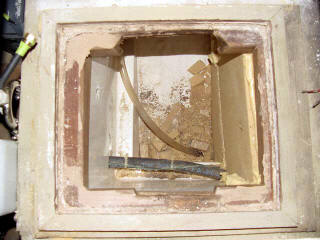 At a used chandlery, I located a fiberglass propane locker designed to
mount under a deck. The dimensions fit the small cockpit locker perfectly
once it's flange was trimmed to the width of the locker. I
began by removing the locker's false bottom to reveal a deep vertical space
filled with chunks of hard foam insulation. I removed the insulation and added a thru-hull for the propane
locker vent. At a used chandlery, I located a fiberglass propane locker designed to
mount under a deck. The dimensions fit the small cockpit locker perfectly
once it's flange was trimmed to the width of the locker. I
began by removing the locker's false bottom to reveal a deep vertical space
filled with chunks of hard foam insulation. I removed the insulation and added a thru-hull for the propane
locker vent.
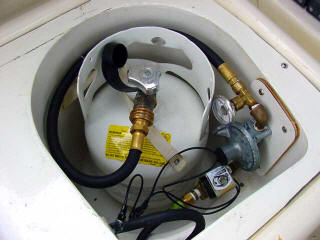
I assembled the new plumbing items to fit against the locker's side
leaving clearance for the 5 lb tank which came with the locker. These
included a new regulator, pressure valve, solenoid, and gas connecting hose.
After assembly, I soap tested all the fittings for leaks.
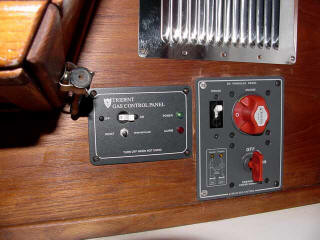 The solenoid came as part of a
package with a new Trident Gas Control Panel which also included an
integrated alarm and sniffer unit. This replaced an older Marinetics control
panel that lacked the alarm feature. I mounted the new unit in the bulkhead
over the icebox in the same cut-out as the older panel. The solenoid came as part of a
package with a new Trident Gas Control Panel which also included an
integrated alarm and sniffer unit. This replaced an older Marinetics control
panel that lacked the alarm feature. I mounted the new unit in the bulkhead
over the icebox in the same cut-out as the older panel.
I mounted the sniffer behind the
galley stove. If it detects fumes, the sniffer sounds an audio alarm through
its built-in speaker. Simultaneously, it trips the breaker in the
Trident panel, turning on a red alarm light and shutting off the gas switch.
Instructions call for the sniffer to be hot wired so that it is always on. I
had problems with this setup. First, the unit appeared to get abnormally hot
to the touch. Second, even though I had soap-tested the propane system and
had a well sealed locker with external drain, the sniffer would go off,
usually after running the diesel.
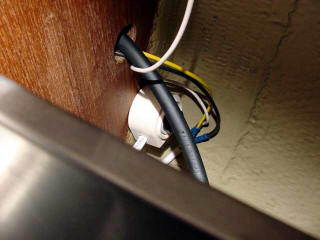 Because the alarm was hot wired, there was no way to shut it
off except to turn off the house batteries, shutting down the frig and
electronics. The last time the sniffer went off, I covered my ears and let
it buzz to see if it would eventually clear itself. Well, it didn't and
eventually it actually began to smoke! It was evident that this unit was
defective and was itself a hazard. After a call to Trident, the tech support
rep agreed. He also said it would be acceptable to wire the sniffer into my
DC panel so I had a way to turn it on and off. Trident replaced the burned
up sniffer with a new unit under warrantee. Now, I only turn the sniffer on
when I'm cooking or when I'm sleeping aboard. This also serves as system
check. When I power the sniffer on, its alarm sounds for 5 to 10 seconds
then it trips the gas control panel breaker, so I know the sniffer is
working properly. (I haven't had any false alarms, even when I've left the
new sniffer on for extended periods.) Because the alarm was hot wired, there was no way to shut it
off except to turn off the house batteries, shutting down the frig and
electronics. The last time the sniffer went off, I covered my ears and let
it buzz to see if it would eventually clear itself. Well, it didn't and
eventually it actually began to smoke! It was evident that this unit was
defective and was itself a hazard. After a call to Trident, the tech support
rep agreed. He also said it would be acceptable to wire the sniffer into my
DC panel so I had a way to turn it on and off. Trident replaced the burned
up sniffer with a new unit under warrantee. Now, I only turn the sniffer on
when I'm cooking or when I'm sleeping aboard. This also serves as system
check. When I power the sniffer on, its alarm sounds for 5 to 10 seconds
then it trips the gas control panel breaker, so I know the sniffer is
working properly. (I haven't had any false alarms, even when I've left the
new sniffer on for extended periods.)
After my sniffer switch modification, the new propane system works quite well.
With the propane locker
opening to the sky, the Trident Gas Control Panel and the on-board sniffer, I believe
I've met all the safety requirements.
|

Scrambled eggs--first meal with the new propane system. |
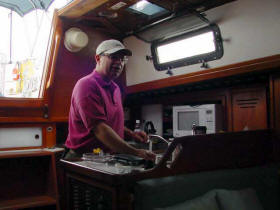
The skipper cleans up in the galley. |
|